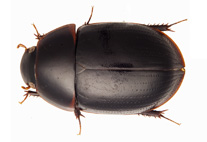Abstract
A new genus and species of Arthrotardigrada is described from Florida, USA based on its unique adhesive pad/claw combinations. Mutaparadoxipus duodigifinis gen. nov., sp. nov., is characterized by well-developed, ventral secondary clavae that are adjacent to the mouth, pointed lateral and caudal alae, seminal receptacles with coiled ducts opening lateral to the gonopore, and all legs with digits bearing proximal adhesive pads. Distal claws are present on digits I–III of legs I–III, but are missing from digit IV. On leg IV, distal claws are present only on digits II & III. A single accessory point is present on claws II & III only. This is the fourth species discovered to date with proximal adhesive pads, increasing support for a clade of adhesive-padded arthrotardigrades, and is likely the sister taxon of Paradoxipus orzeliscoides. The incomplete set of claws may represent an evolutionary step in a progressive loss of claws hypothesized to have occurred within the Halechiniscidae. The subfamily Orzeliscinae is amended as a result.

